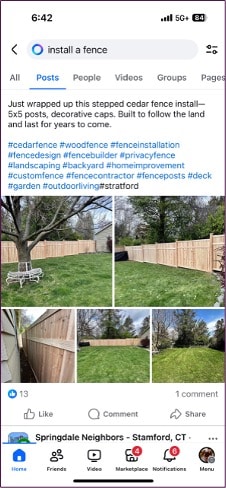Consumer Research Techniques- The Foundation of Local Business Marketing
1. What Questions Are Your Customers Really Asking?
Tools like AnswerThePublic help uncover the exact language customers use when researching products or services. Enter any topic, and you’ll see clusters of real-world queries: “Which fence lasts the longest?”, “Is vinyl fencing cheaper than wood?” These aren’t assumptions—they’re real questions. Knowing what people want to know is the foundation of high-impact customer behavior analysis. The free version allows for three searches a day, making it accessible and effective.

2. What Are Consumers Saying on Social Media—And Why Should You Listen?
Social media listening captures feedback straight from the source. While paid tools make the process easier, even free methods reveal powerful insights. Search for your product or service on Facebook—try a phrase like “install a fence”. Then, filter by “Posts”. What do people say? What matters to them? Which companies are mentioned, and what influences their decisions?It’s raw, unfiltered consumer behavior data. For another layer, run the same query on Reddit. These platforms let you hear how people talk, complain, recommend, and decide. Social listening like this remains one of the most direct consumer research techniques available.
3. Which Trends Are Shaping Consumer Decisions Right Now?
Google Trends reveals the shifting interests and behavior patterns of your market in real time. Explore rising topics, search volumes by region, related keywords, news headlines, and even spikes in video content. When used regularly, this tool highlights seasonal interest, regional surges, or emerging needs your business can respond to. It’s not just keyword tracking—
it’s strategic trend awareness embedded in a platform many businesses overlook.
4. Are You Making the Most of the Data You Already Have?
Google Analytics, especially GA4, houses a deep archive of behavioral signals that show exactly how customers engage with your site. What pages do they visit? How long do they stay? What actions do they take before exiting? Segment your audience by behavior, referral source, or device. Many local businesses underuse this tool, but it’s arguably the richest internal source of market research methods available to any company.
(For businesses needing support with setup and interpretation, visit our AI Website Chatbot or Free Website Grader.)
5. What Can Meta’s Data Tell You About Your Audience?
If you’ve installed the Meta Pixel on your website, you have access to Meta Business Suite’s Audience Insights tool. This platform uncovers demographics, content preferences, and purchase behaviors from those interacting with your brand on Facebook and Instagram. But it doesn’t stop there. You can build lookalike audiences and test campaigns based on this behavioral data, allowing for ongoing refinement and deeper buyer persona development.
6. Where Do Your Customers Hang Out Online—and Why Does It Matter?
SparkToro analyzes publicly available data to uncover the digital behaviors of your target audience. Which social accounts do they follow? What podcasts do they listen to? What hashtags do they use? For both B2C and B2B, this tool offers a peek into what captures your audience’s attention—without relying on third-party cookies. Up to 20 searches per month are free, and each one can inform new content, partnerships, and targeting opportunities.
7. Have You Asked Your Current Customers the Right Questions?
Direct feedback from existing customers often provides insight that no tool can replicate. Whether it’s through surveys, automated follow-ups, or one-on-one calls, ask about motivations, frustrations, decision triggers, and post-purchase impressions. What do they value most? What nearly stopped them from buying? These conversations are rich with detail that algorithms miss. Engaging customers after the sale not only fuels better consumer research techniques, it also supports retention and brand trust.
(If you need help automating this process, learn more about our Sales Enabled Marketing approach.)
Understanding the ideal customer isn’t a static exercise. It’s a continuous loop of listening, observing, asking, and adapting. These seven techniques help translate fragmented signals into real understanding—turning research into action, and action into growth.
Frequently Asked Questions
What are the best free tools for consumer research?
Some of the most effective free tools include Google Trends, AnswerThePublic, Reddit, and SparkToro. These platforms help uncover audience behavior, trending topics, and the specific questions consumers are asking online.
How can social media listening help improve my marketing strategy?
Social media listening allows you to observe real conversations and opinions in your niche. It reveals customer pain points, decision factors, and brand preferences in their own words—key inputs for tailoring messaging and offers.
Why is customer feedback more valuable than analytics alone?
Analytics show what users do; feedback explains why they do it. Talking to customers directly uncovers motivations, objections, and unmet needs that data dashboards can’t fully explain.
What insights can I get from Google Analytics beyond traffic reports?
With GA4, you can track customer journeys, segment audiences by behavior, and measure conversion actions. It’s especially powerful when combined with tools like Meta Pixel or CRM platforms for deeper funnel analysis.
How do I know which consumer research method is right for my business?
Start by identifying your goals. If you want to understand buyer psychology, use surveys and live chat transcripts. If you’re exploring market trends, try Google Trends or AnswerThePublic. For real-time social sentiment, platforms like Reddit and SparkToro are ideal.









